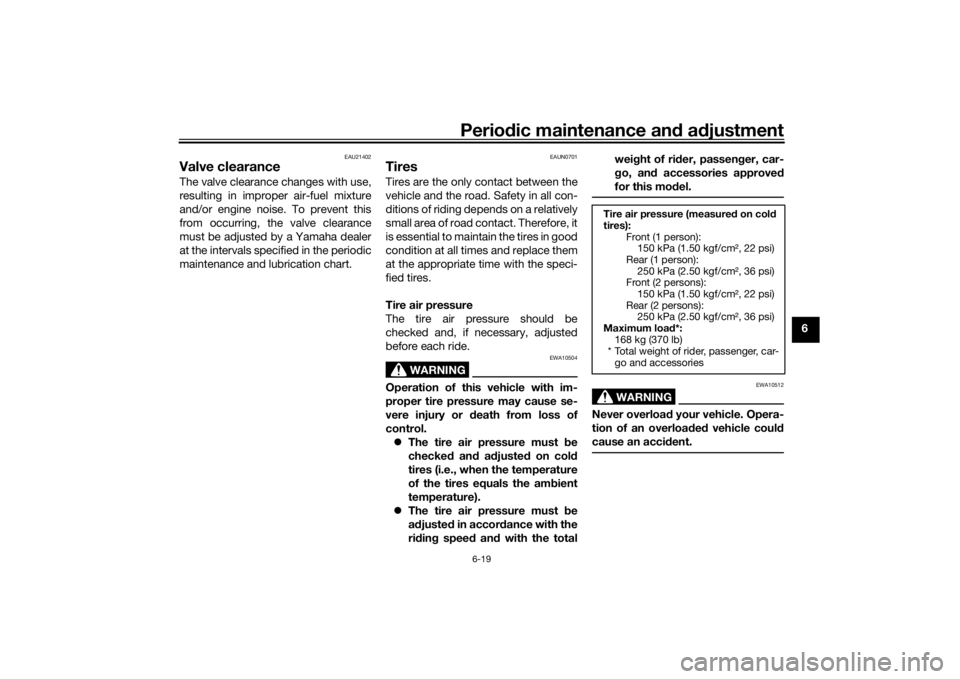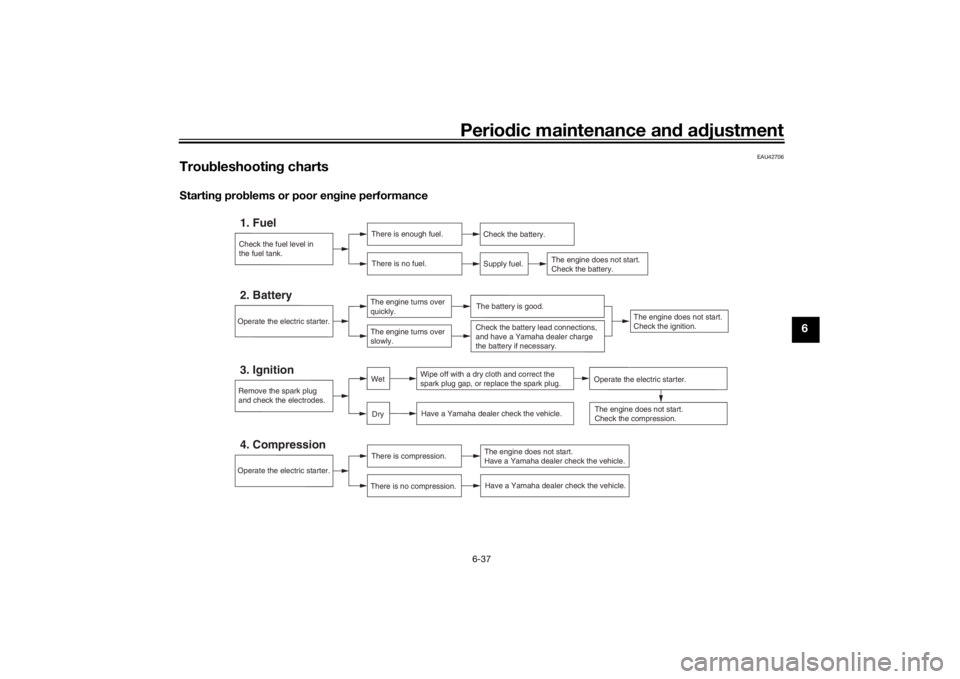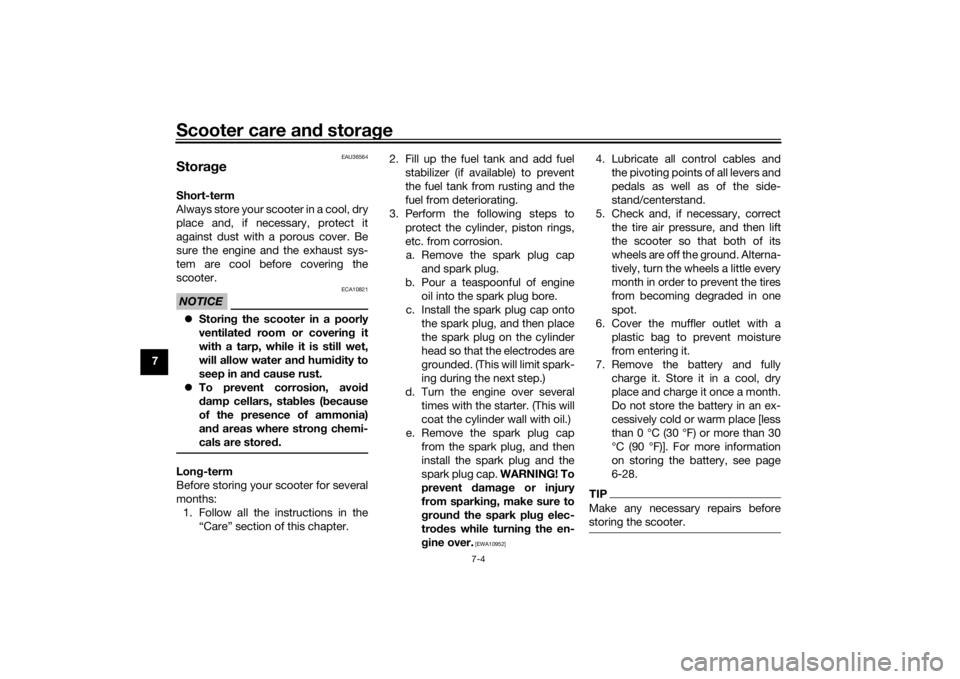check engine YAMAHA NMAX 2015 Owner's Manual
[x] Cancel search | Manufacturer: YAMAHA, Model Year: 2015, Model line: NMAX, Model: YAMAHA NMAX 2015Pages: 90, PDF Size: 3.56 MB
Page 59 of 90

Periodic maintenance an d a djustment
6-19
6
EAU21402
Valve clearanceThe valve clearance changes with use,
resulting in improper air-fuel mixture
and/or engine noise. To prevent this
from occurring, the valve clearance
must be adjusted by a Yamaha dealer
at the intervals specified in the periodic
maintenance and lubrication chart.
EAUN0701
TiresTires are the only contact between the
vehicle and the road. Safety in all con-
ditions of riding depends on a relatively
small area of road contact. Therefore, it
is essential to maintain the tires in good
condition at all times and replace them
at the appropriate time with the speci-
fied tires.
Tire air pressure
The tire air pressure should be
checked and, if necessary, adjusted
before each ride.
WARNING
EWA10504
Operation of this vehicle with im-
proper tire pressure may cause se-
vere injury or d eath from loss of
control. The tire air pressure must b e
checked and a djuste d on col d
tires (i.e., when the temperature
of the tires equals the am bient
temperature).
The tire air pressure must b e
a d juste d in accor dance with the
ri din g speed and with the total wei
ght of ri der, passen ger, car-
g o, an d accessories approve d
for this mo del.
WARNING
EWA10512
Never overloa d your vehicle. Opera-
tion of an overloa ded vehicle coul d
cause an acci dent.
Tire air pressure (measure d on col d
tires): Front (1 person):150 kPa (1.50 kgf/cm2, 22 psi)
Rear (1 person): 250 kPa (2.50 kgf/cm2, 36 psi)
Front (2 persons):
150 kPa (1.50 kgf/cm2, 22 psi)
Rear (2 persons): 250 kPa (2.50 kgf/cm2, 36 psi)
Maximum loa d*:
168 kg (370 lb)
* Total weight of rider, passenger, car-
go and accessories
U2DSE0E0.book Page 19 Thursday, March 19, 2015 10:34 AM
Page 77 of 90

Periodic maintenance an d a djustment
6-37
6
EAU42706
Trou bleshootin g chartsStartin g prob lems or poor en gine performance
Check the fuel level in
the fuel tank.1. Fuel
There is enough fuel.
There is no fuel.
Check the battery.
Supply fuel.
The engine does not start.
Check the battery.
Operate the electric starter.4. Compression
There is compression.
There is no compression.
The engine does not start.
Have a Yamaha dealer check the vehicle.Have a Yamaha dealer check the vehicle.
Remove the spark plug
and check the electrodes.3. Ignition
Wipe off with a dry cloth and correct the
spark plug gap, or replace the spark plug. Have a Yamaha dealer check the vehicle.
The engine does not start.
Check the compression.
Operate the electric starter.2. Battery
The engine turns over
quickly.
The engine turns over
slowly.
The battery is good.
DryWet
Operate the electric starter.
Check the battery lead connections,
and have a Yamaha dealer charge
the battery if necessary.
The engine does not start.
Check the ignition.
U2DSE0E0.book Page 37 Thursday, March 19, 2015 10:34 AM
Page 78 of 90

Periodic maintenance an d a djustment
6-38
6 En
gine overheatin g
WARNING
EWAT1041
Do not remove the ra diator cap when the en gine an d ra diator are hot. Scal din g hot flui d an d steam may be
b lown out un der pressure, which coul d cause serious injury. Be sure to wait until the en gine has coole d.
Place a thick ra g, like a towel, over the ra diator cap, an d then slowly rotate the cap counterclockwise to the
d etent to allow any resi dual pressure to escape. When the hissin g soun d has stoppe d, press d own on the cap
while turnin g it counterclockwise, an d then remove the cap.TIPIf coolant is not available, tap water can be temporarily used instead, provided that it is changed to the recommended cool-
ant as soon as possible.
Wait until the
engine has cooled.
Check the coolant level in the
reservoir and radiator.
The coolant level
is OK.The coolant level is low.
Check the cooling system
for leakage.
Have a Yamaha dealer checkand repair the cooling system.Add coolant. (See TIP.)
Start the engine. If the engine overheats again,
have a
Yamaha dealer check
and repair the cooling system.
There is
leakage.
There is
no leakage.
U2DSE0E0.book Page 38 Thursday, March 19, 2015 10:34 AM
Page 82 of 90

Scooter care and stora ge
7-4
7
EAU36564
Stora geShort-term
Always store your scooter in a cool, dry
place and, if necessary, protect it
against dust with a porous cover. Be
sure the engine and the exhaust sys-
tem are cool before covering the
scooter.NOTICE
ECA10821
Storin g the scooter in a poorly
ventilate d room or coverin g it
with a tarp, while it is still wet,
will allow water an d humi dity to
seep in an d cause rust.
To prevent corrosion, avoi d
d amp cellars, sta bles ( because
of the presence of ammonia)
an d areas where stron g chemi-
cals are stored .Long-term
Before storing your scooter for several
months: 1. Follow all the instructions in the “Care” section of this chapter. 2. Fill up the fuel tank and add fuel
stabilizer (if available) to prevent
the fuel tank from rusting and the
fuel from deteriorating.
3. Perform the following steps to protect the cylinder, piston rings,
etc. from corrosion.a. Remove the spark plug cap and spark plug.
b. Pour a teaspoonful of engine oil into the spark plug bore.
c. Install the spark plug cap onto the spark plug, and then place
the spark plug on the cylinder
head so that the electrodes are
grounded. (This will limit spark-
ing during the next step.)
d. Turn the engine over several times with the starter. (This will
coat the cylinder wall with oil.)
e. Remove the spark plug cap from the spark plug, and then
install the spark plug and the
spark plug cap. WARNING! To
prevent dama ge or injury
from sparkin g, make sure to
g roun d the spark plu g elec-
tro des while turnin g the en-
g ine over.
[EWA10952]
4. Lubricate all control cables and
the pivoting points of all levers and
pedals as well as of the side-
stand/centerstand.
5. Check and, if necessary, correct the tire air pressure, and then lift
the scooter so that both of its
wheels are off the ground. Alterna-
tively, turn the wheels a little every
month in order to prevent the tires
from becoming degraded in one
spot.
6. Cover the muffler outlet with a plastic bag to prevent moisture
from entering it.
7. Remove the battery and fully charge it. Store it in a cool, dry
place and charge it once a month.
Do not store the battery in an ex-
cessively cold or warm place [less
than 0 °C (30 °F) or more than 30
°C (90 °F)]. For more information
on storing the battery, see page
6-28.TIPMake any necessary repairs before
storing the scooter.
U2DSE0E0.book Page 4 Thursday, March 19, 2015 10:34 AM
Page 88 of 90

10-1
10
IndexAABS ....................................................... 3-11
ABS warning light ................................... 3-3
Acceleration and deceleration ................ 5-2
Air filter and V-belt case air filter
elements ............................................. 6-16
Auxiliary light bulb, replacing ................ 6-31BBattery .................................................. 6-28
Brake fluid, changing ............................ 6-24
Brake fluid level, checking .................... 6-22
Brake lever, front .................................. 3-10
Brake lever, rear.................................... 3-11
Brake levers, lubricating ....................... 6-25
Brake light ............................................. 6-32
Braking.................................................... 5-2CCables, checking and lubricating ......... 6-24
Care ........................................................ 7-1
Catalytic converter ................................ 3-14
Centerstand and sidestand, checking and lubricating .................... 6-26
Coolant ................................................. 6-13
Coolant temperature warning light ......... 3-3DDimmer switch ...................................... 3-10EEngine break-in....................................... 5-3
Engine oil and oil strainer...................... 6-10
Engine serial number .............................. 9-1
Engine trouble warning light ................... 3-3FFinal transmission oil ............................ 6-12 Front and rear brake lever free play,
checking............................................. 6-21
Front and rear brake pads, checking ... 6-22
Front fork, checking ............................. 6-26
Fuel ....................................................... 3-13
Fuel consumption, tips for reducing ...... 5-3
Fuel tank cap ........................................ 3-12
Fuel tank overflow hose ....................... 3-14
Fuses, replacing ................................... 6-29
HHandlebar switches .............................. 3-10
Headlight .............................................. 6-30
High beam indicator light ....................... 3-3
Horn switch .......................................... 3-10IIdentification numbers ............................ 9-1
Ignition circuit cut-off system ............... 3-17
Indicator lights and warning lights ......... 3-2KKeyhole shutter ...................................... 3-2MMain switch/steering lock....................... 3-1
Maintenance and lubrication, periodic ... 6-3
Maintenance, emission control system.................................................. 6-2
Matte color, caution ............................... 7-1
Model label ............................................. 9-1
Multi-function meter unit ........................ 3-4PPanels, removing and installing .............. 6-7
Parking ................................................... 5-4
Part locations ......................................... 2-1SSafe-riding points ................................... 1-5 Safety information ...................................1-1
Seat .......................................................3-15
Sidestand ..............................................3-17
Spark plug, checking ..............................6-8
Specifications .........................................8-1
Starting off ..............................................5-2
Starting the engine ..................................5-1
Start switch ...........................................3-10
Steering, checking ................................6-27
Storage ...................................................7-4
Storage compartments .........................3-16
TTaillight bulb, replacing .........................6-32
Throttle grip and cable,
checking and lubricating ....................6-25
Throttle grip free play, checking ...........6-18
Tires ......................................................6-19
Tool kit ....................................................6-1
Troubleshooting ....................................6-36
Troubleshooting charts .........................6-37
Turn signal indicator lights ......................3-2
Turn signal light bulb (front),
replacing .............................................6-34
Turn signal light bulb (rear), replacing .............................................6-35
Turn signal switch .................................3-10VValve clearance .....................................6-19
V-belt, checking ....................................6-24
Vehicle identification number ..................9-1WWheel bearings, checking .....................6-27
Wheels ..................................................6-21
U2DSE0E0.book Page 1 Thursday, March 19, 2015 10:34 AM